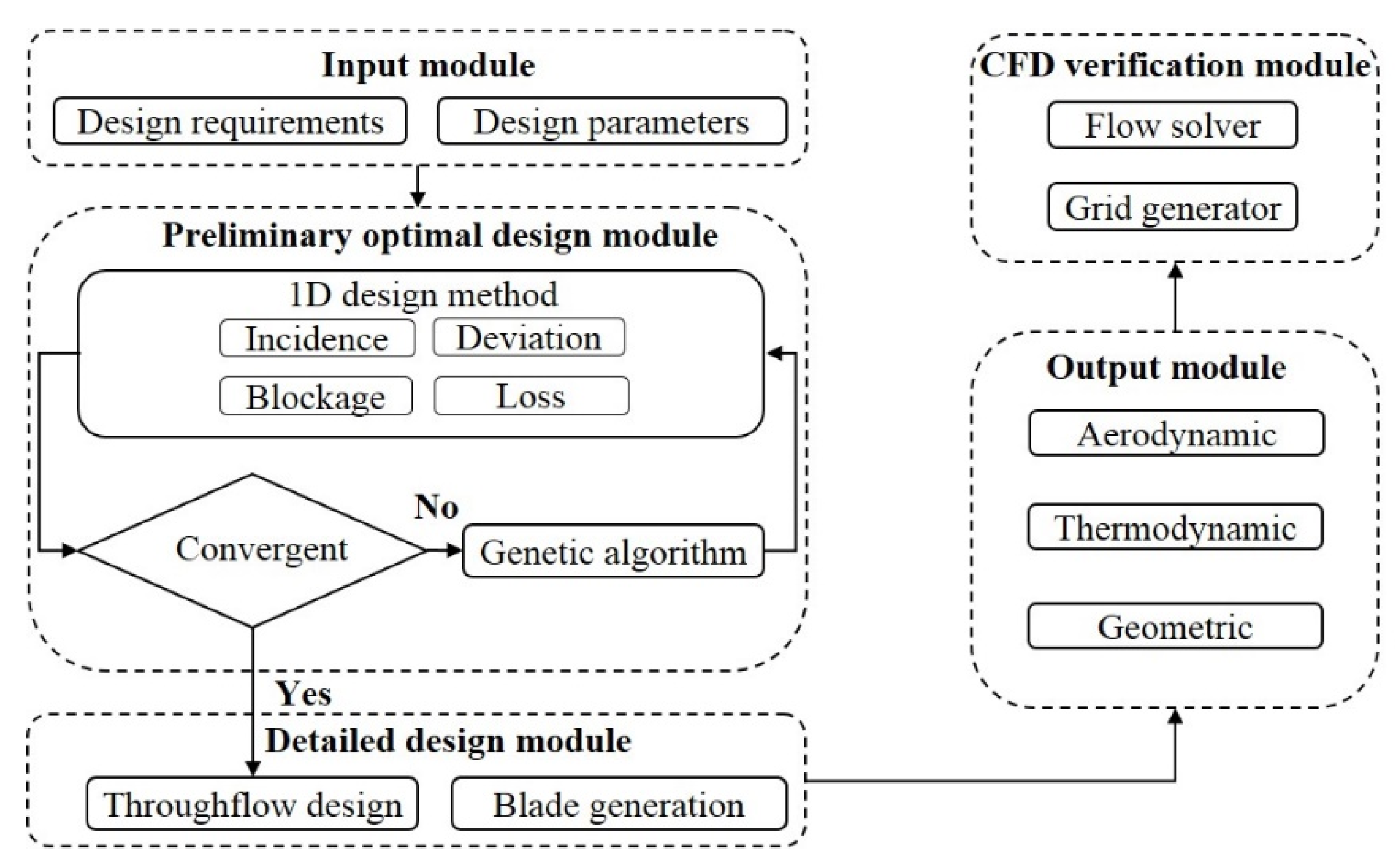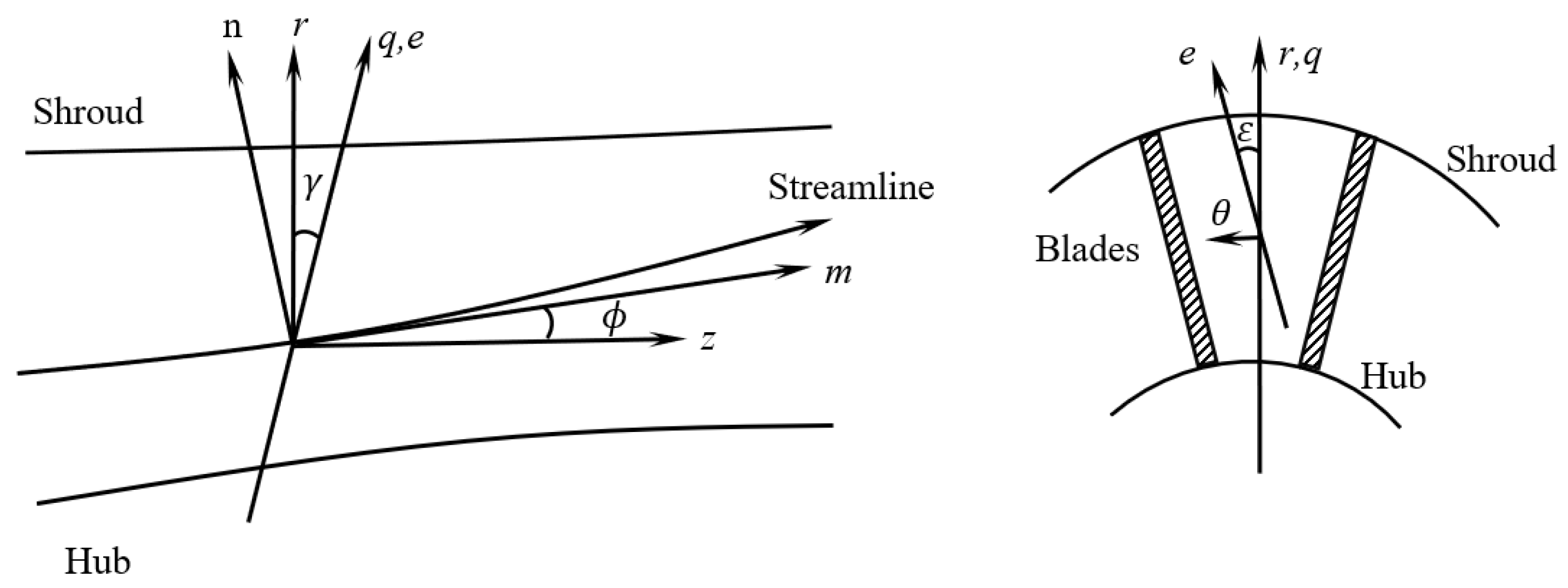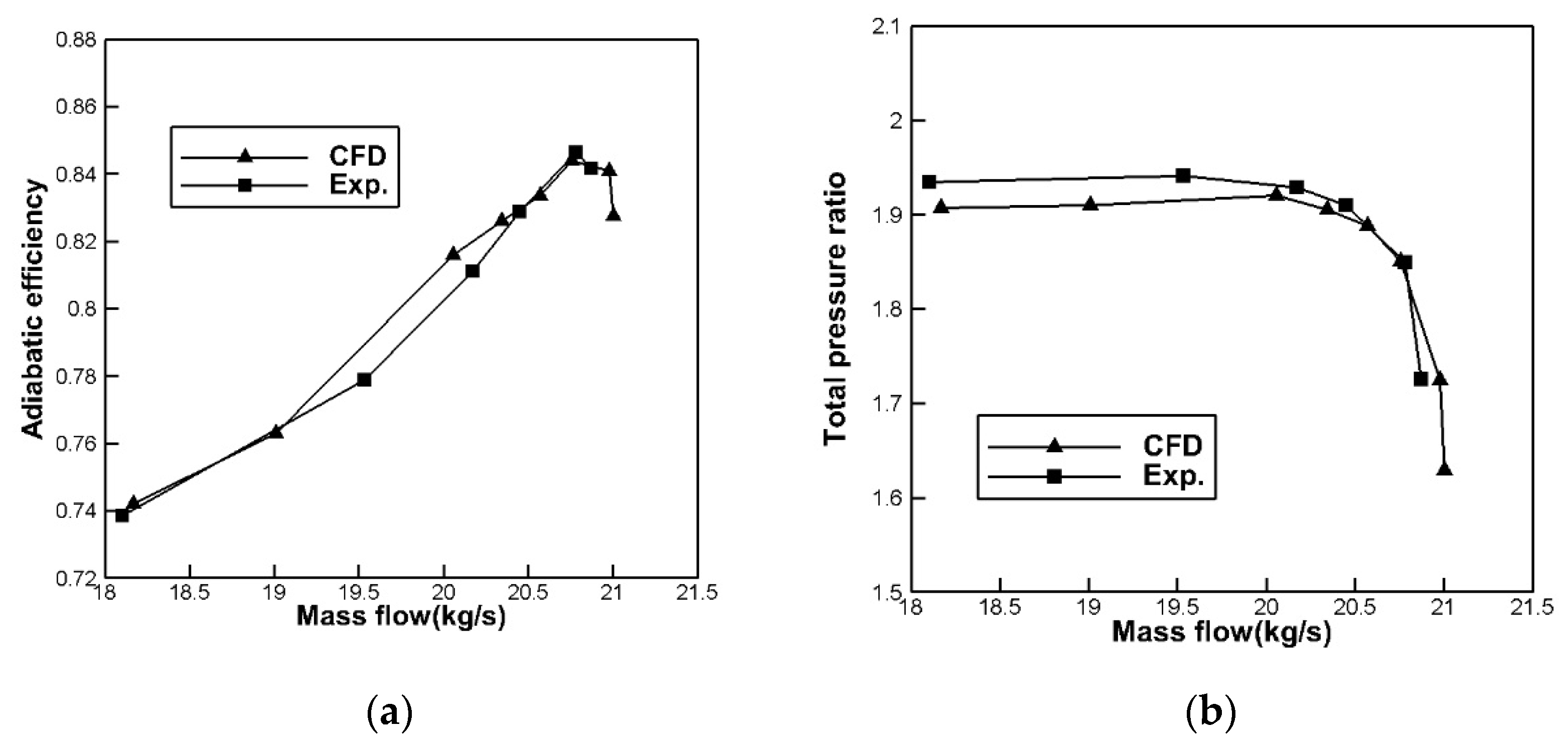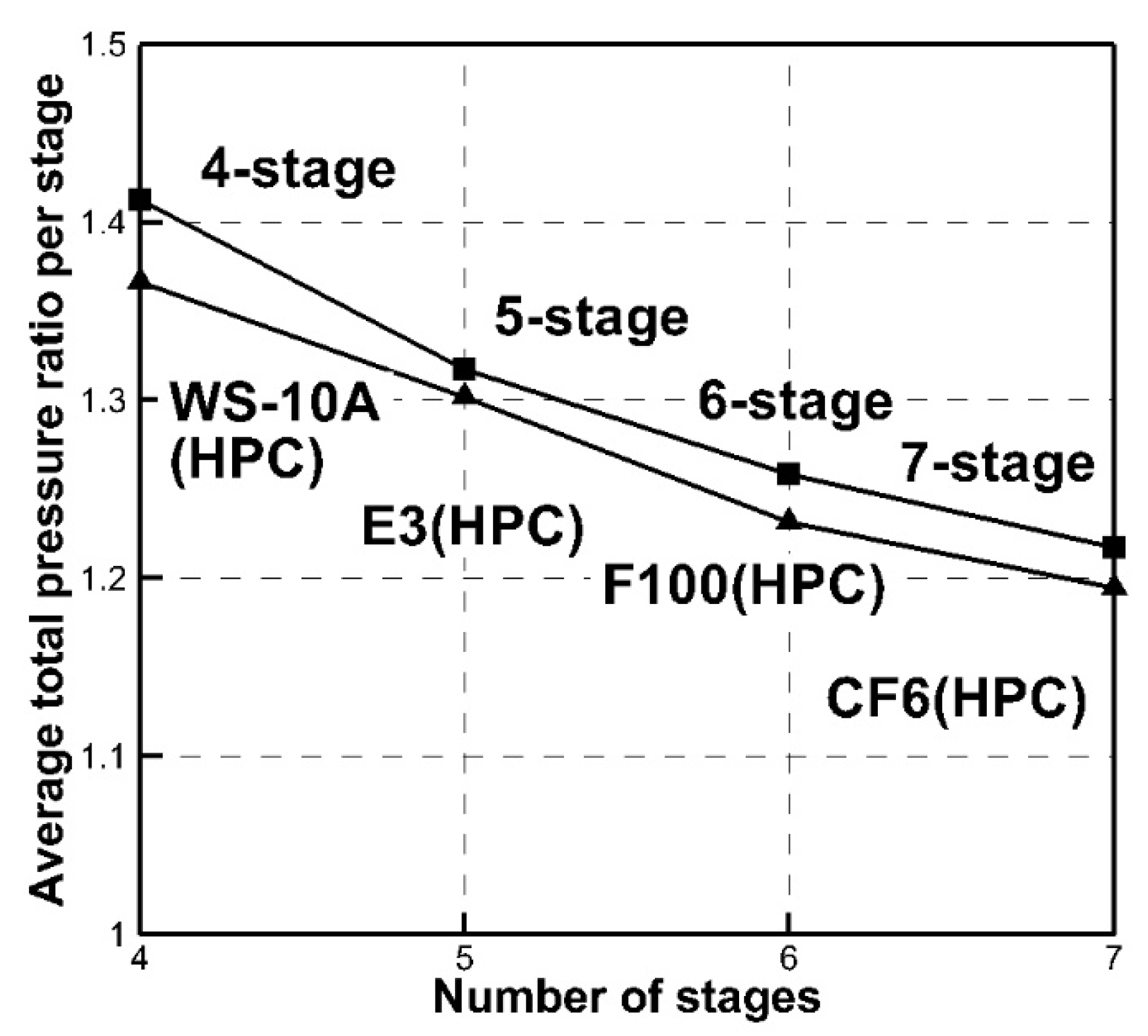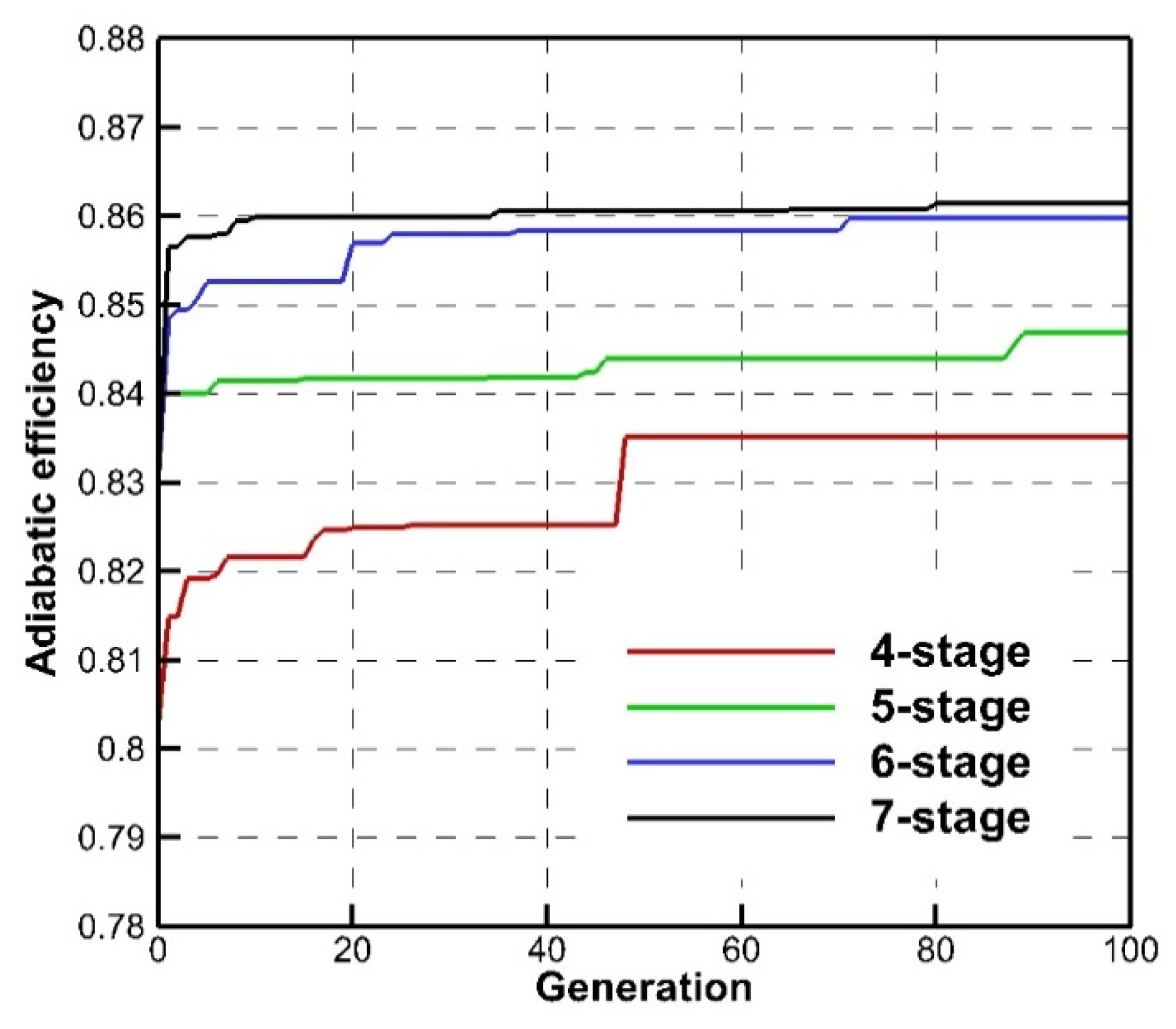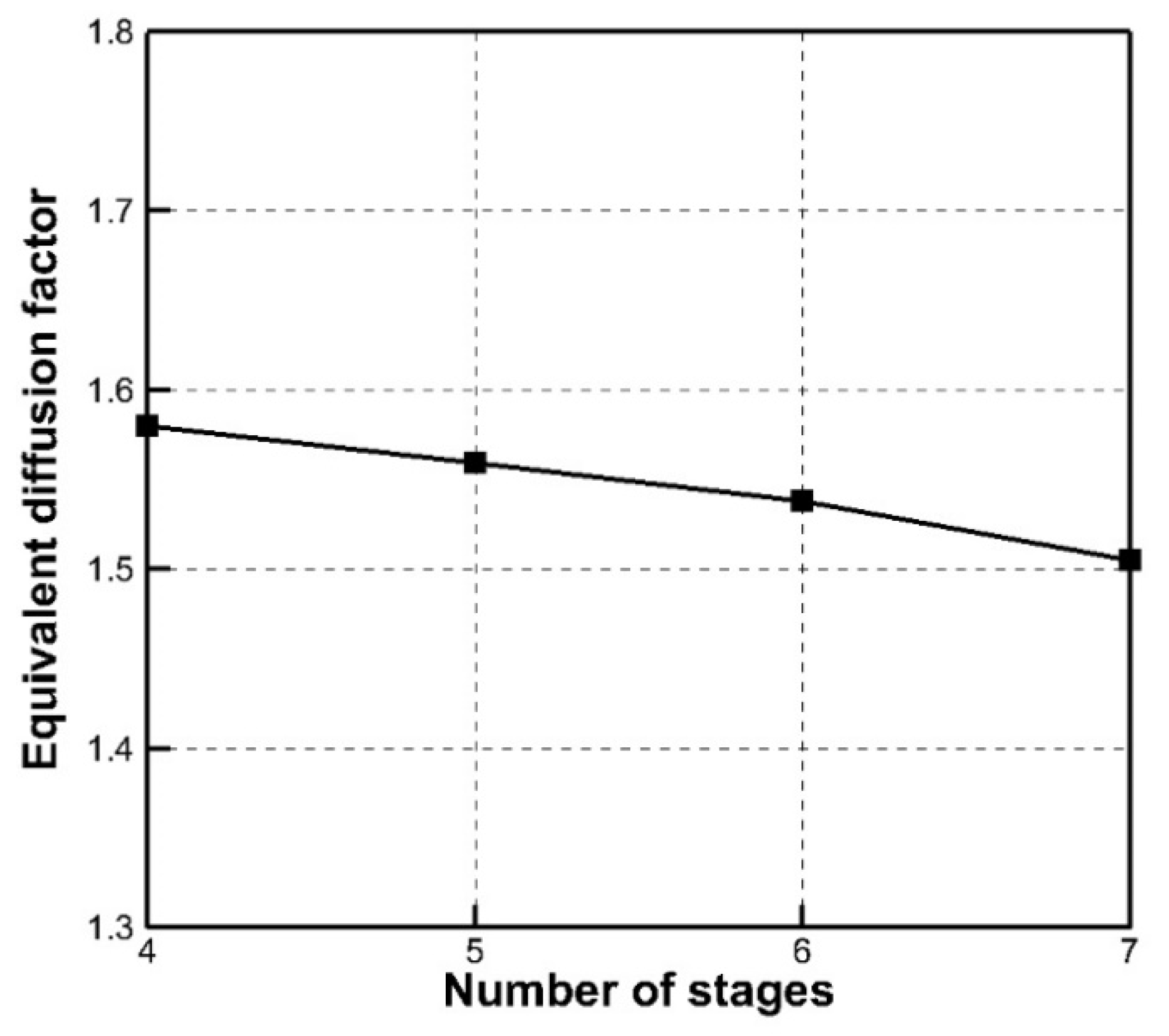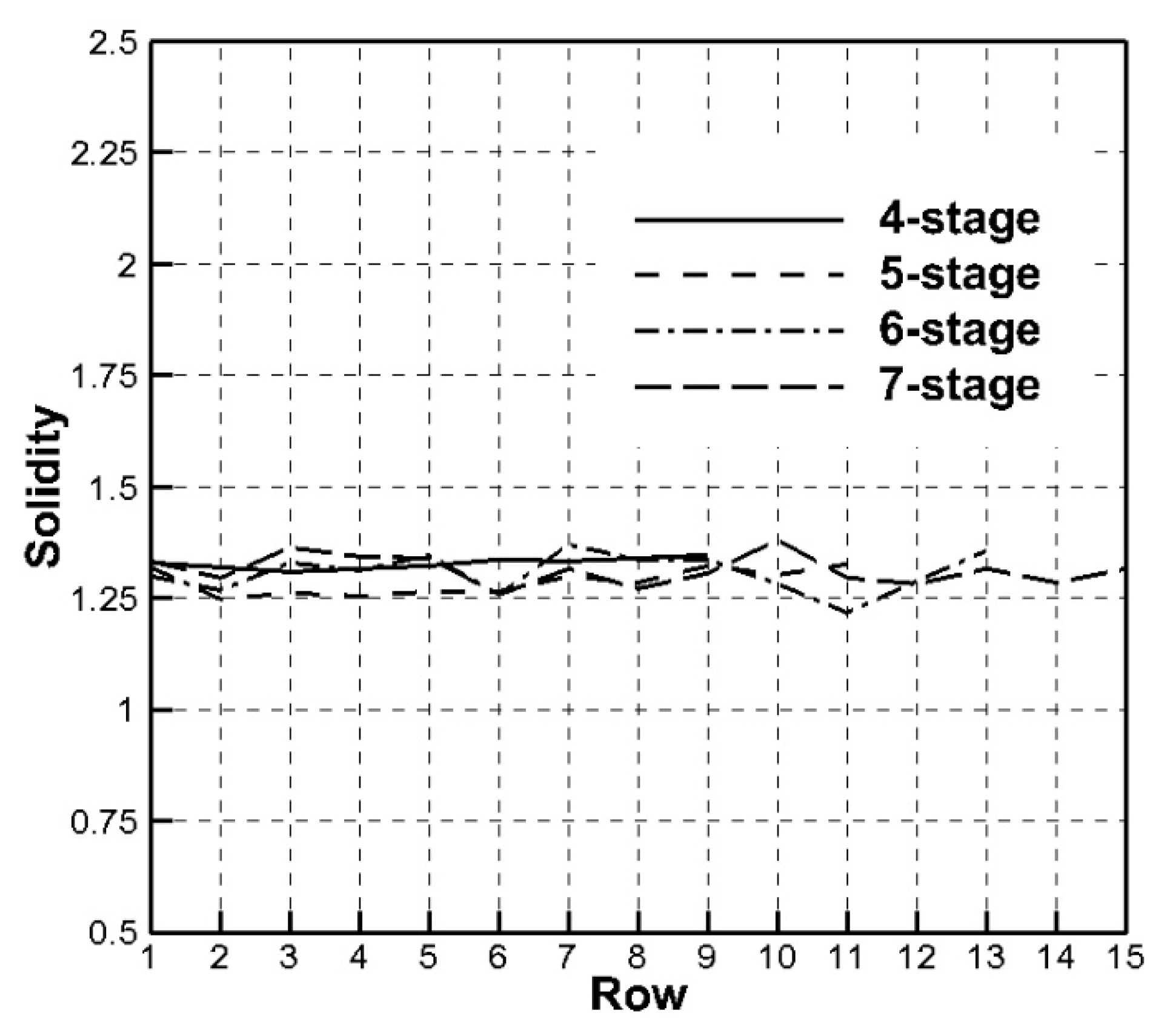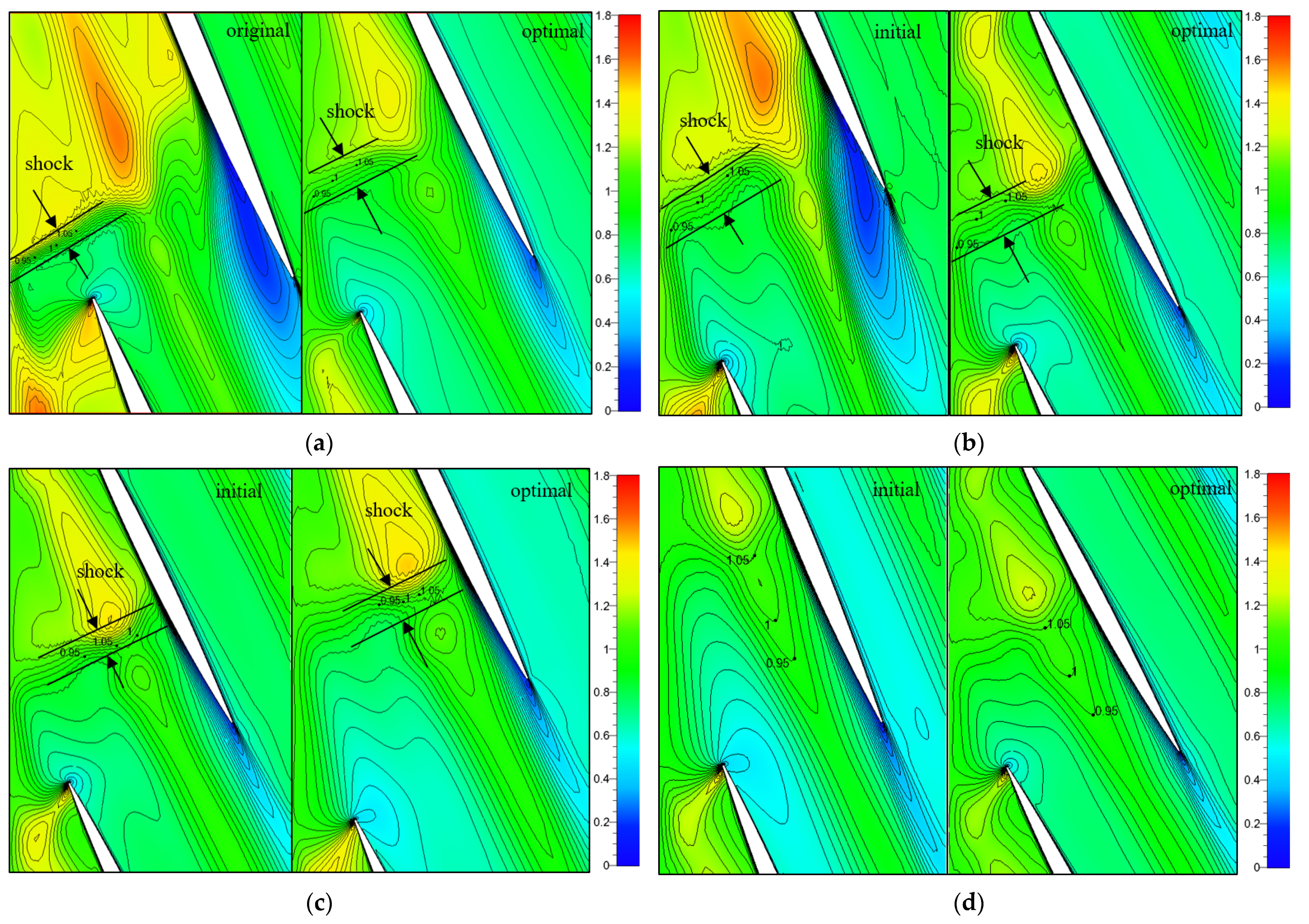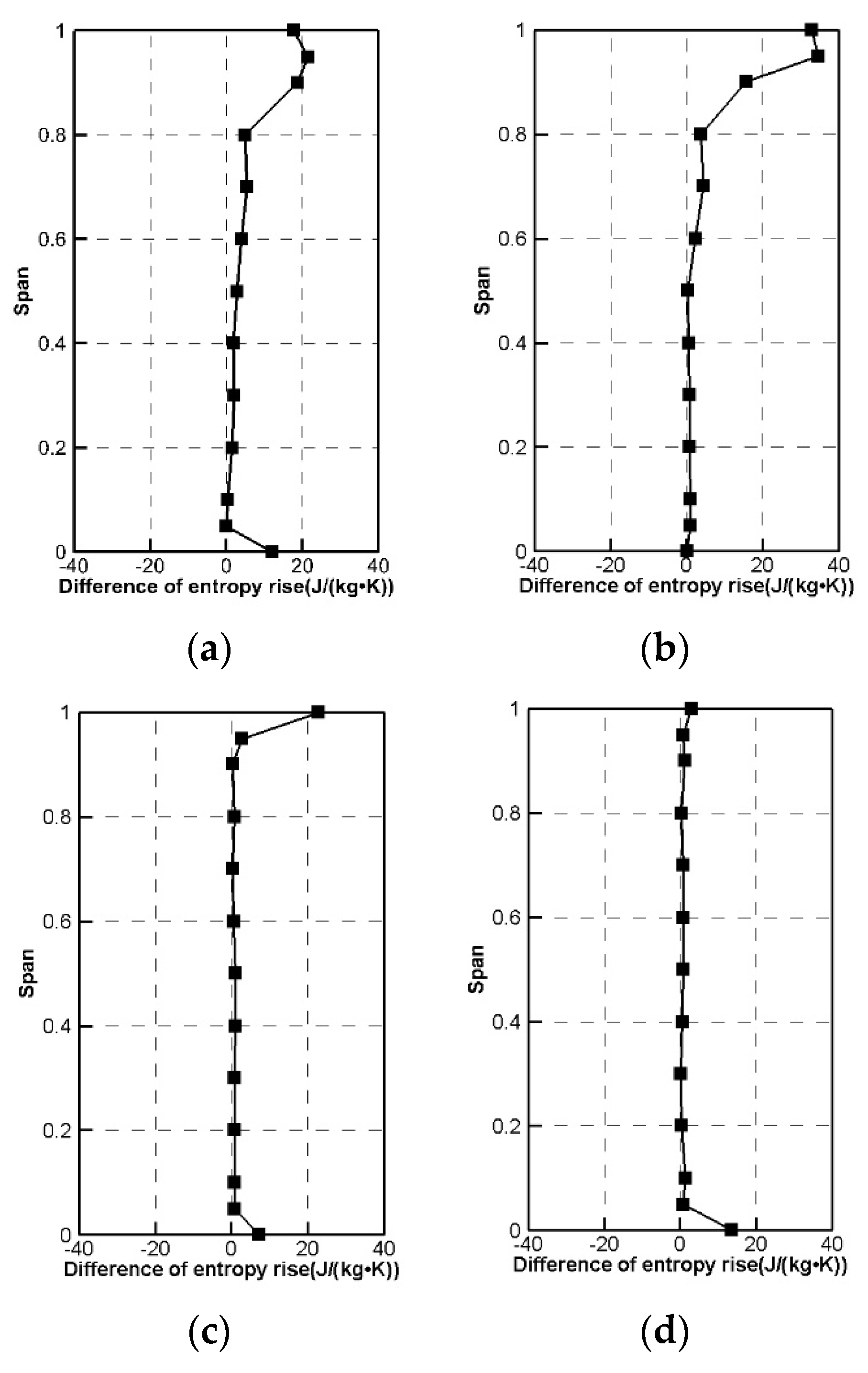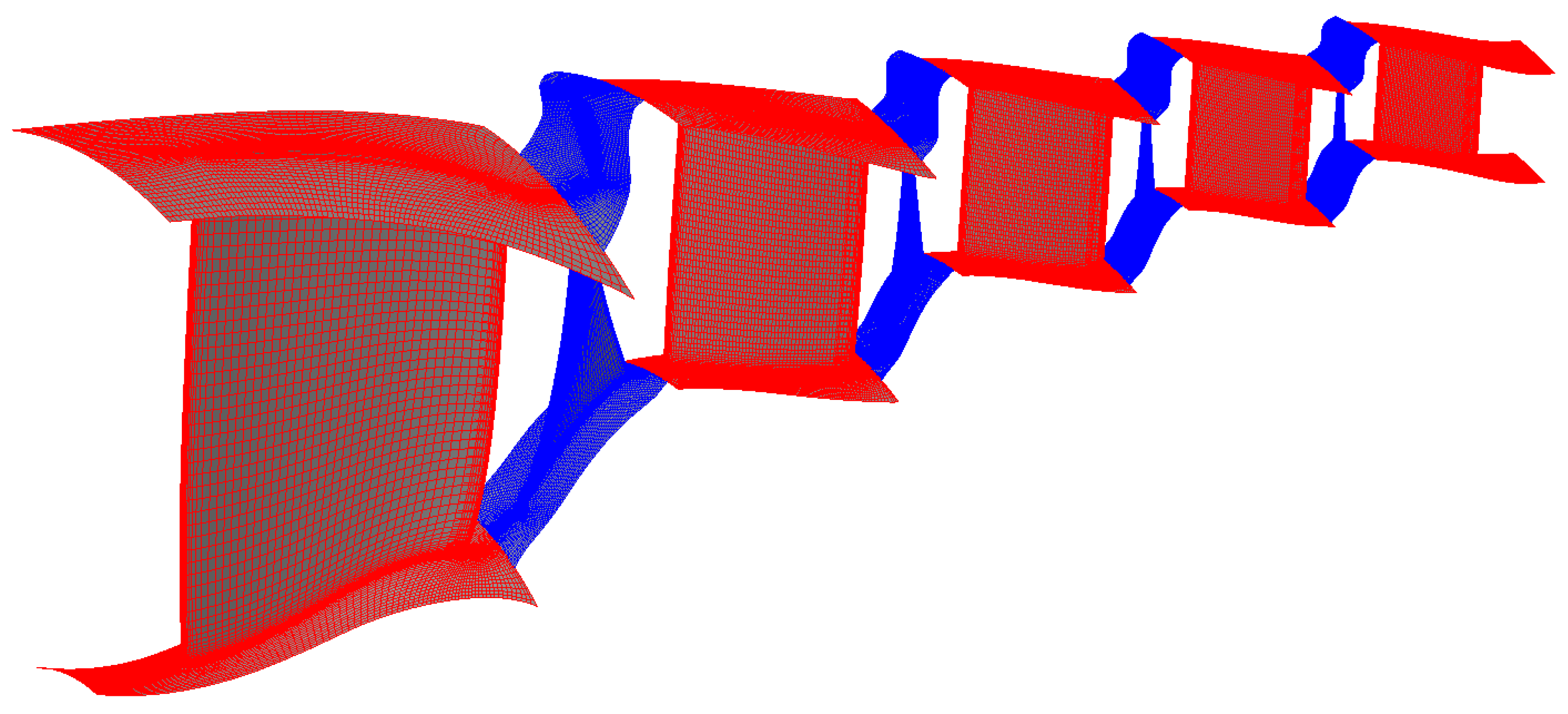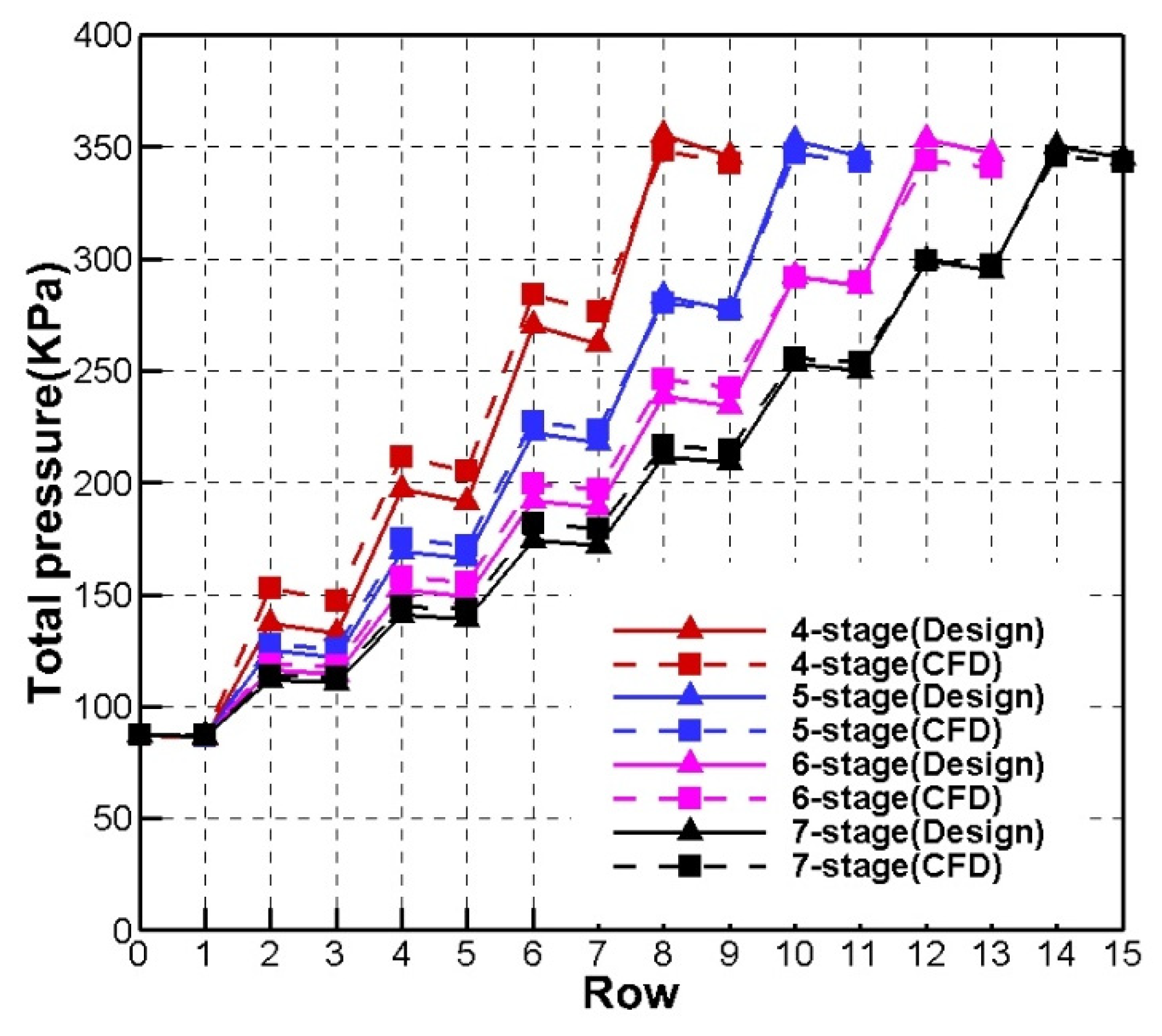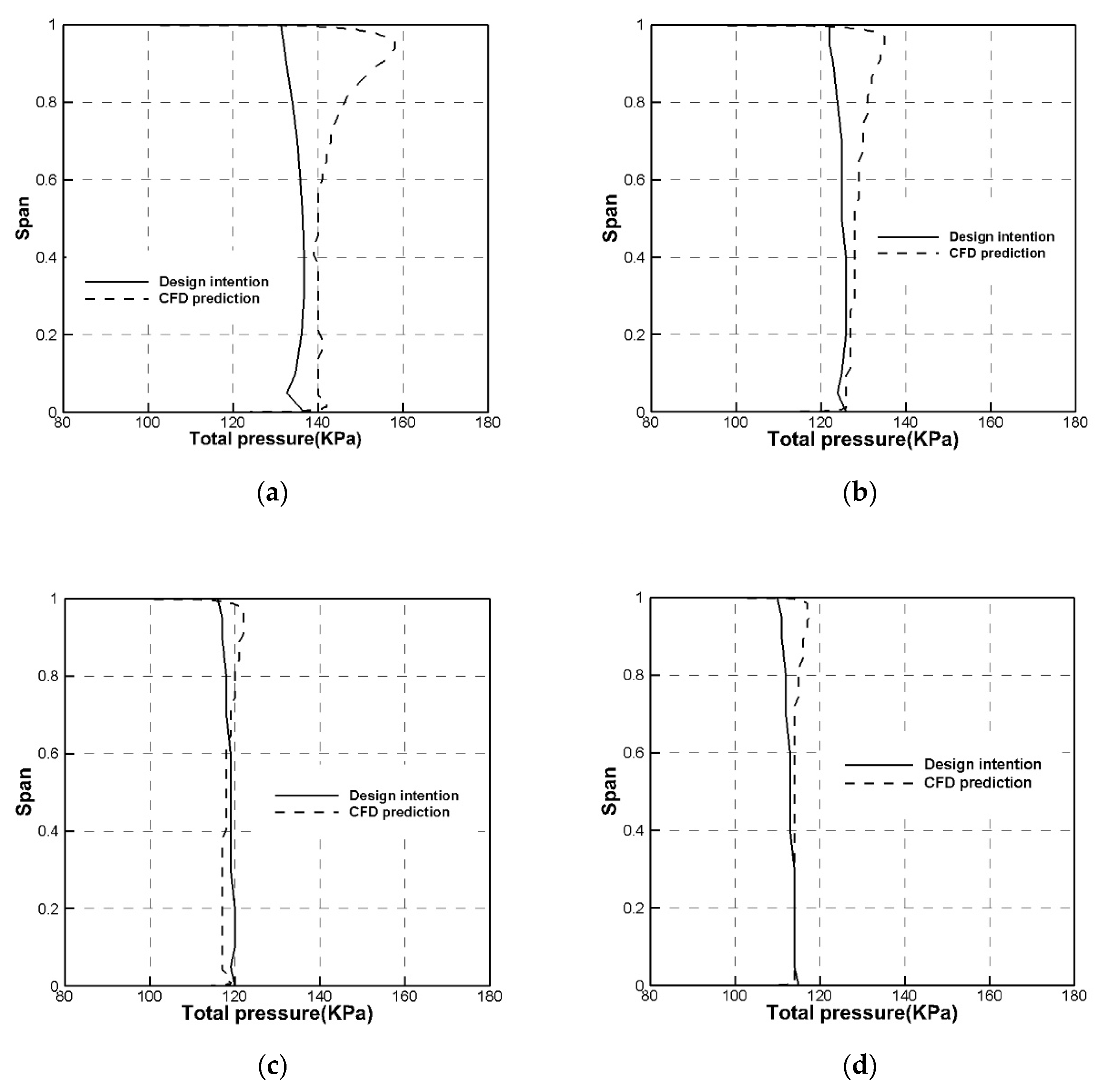5.2. Results and Discussion
The optimal convergence curves of the four kinds of compressors are illustrated in
Figure 5. The initial and optimal design results of 4-stage, 5-stage, 6-stage, and 7-stage compressors are demonstrated in
Table 3. The design adiabatic efficiency of the four kinds of compressors increases effectively while mass flow rate and total pressure ratio changes are negligible after optimization. It can also be found that the optimal design adiabatic efficiency decreases with a decrease of the number of stages. With the same total pressure ratio for those four types of compressors, the increase of the number of stages brings about the decline of the pressure ratio and the Lieblein equivalent diffusion factor [
24] of each stage (
Figure 6).
Figure 7 illustrates the spanwise distribution of optimal Lieblein equivalent diffusion factors of rotor 1 and stator 1 for 4-stage, 5-stage, 6-stage, and 7-stage compressors. The lower optimal reaction of 4-stage and 5-stage compressors (
Table 4) means the relatively higher loading of the stator. The equivalent diffusion factors of stator 1 of 4-stage and 5-stage compressors are quite higher than those of 6-stage and 7-stage compressors. On the whole, for both rotor 1 and stator 1 of these four compressors, the equivalent diffusion factors along the spanwise direction decrease among the most span range as the number of stages increases. Hence fewer stages will penalize efficiency within a reasonable loading range.
To reveal the aerodynamic mechanism behind the optimization of performance, the variations of the six types of design parameters, including aspect ratio, solidity, reaction, rotation speed, outlet axial Mach number, and inlet radius ratio, are analyzed in detail below.
Table 4 shows that a higher efficiency is obtained with a little decline of solidity. As solidity decreases,
will decrease [
28]. The optimal average solidities at midspan of the four types of compressors vary within a small range from 1.28 to 1.33. As shown in
Figure 8, the stagewise optimal solidities of the four compressors are around 1.3. These optimal results reveal that for a compressor with an aforementioned stage load level, an average solidity between 1.28 and 1.33 would be beneficial to the efficiency. Notably, the IGV was denoted as the first row.
As shown in
Table 4, optimal efficiency was achieved after the average aspect ratio slightly increased. This is also consistent with the fact that a higher aspect ratio results in a larger blade height, which in turn reduces the axial velocity. Accordingly, the relative Mach number would be kept lower as well as the flow loss would be improved. Notably, the optimal average aspect ratio increases from 1.44 to 1.58 as the number of stages increases. When the number of stages increases, the pressure ratio and density ratio of all stages decrease, as does the axial velocity. Hence a larger flow area is required to maintain the same flow rate. This could be achieved with a higher aspect ratio.
Figure 9 illustrate the optimal aspect ratio along the stagewise direction. As can be seen, its nearly linear descent gradually approaches the same level of around 1.25 at the final outlet.
Meanwhile, the optimal efficiency corresponds to a lower value of the average reaction relative to the initial reactions. The optimal average reaction increases from 0.44 to 0.49 as the number of stages increases. Reaction reflects the compression capacity of the rotor with respect to that of the stator. A higher reaction level means higher compression capacity as well as extremely high inlet Mach number of rotors, which will deteriorate the efficiency of rotors. Similarly, a lower reaction will deteriorate the efficiency of the stators. Hence a moderate level of the reaction would be preferred for better efficiency of a stage.
Table 4 also shows that optimal efficiency can be obtained with a slight decline of rotation speed. At optimal operating conditions, relative velocity or equivalently the relative Mach number is slightly reduced, and thereby the shock intensity becomes moderate, with a little less shock loss. As seen, the optimal rotation speed decreases from 6125 rpm to 4053 rpm as the number of stages increases. It can be deduced from the Euler equation that a positive correlation between the rotation speed and the theoretical work exists. Under the same total pressure ratio, the average stage theoretical work decreases as the number of stages increases, resulting in a decrease of the rotation speed.
As shown in
Table 4, an increase of outlet axial Mach number can give rise to improved efficiency. The initial and optimal outlet axial Mach number are basically at the same level (around 0.34). An acceleration treatment for axial velocity at the inlet and outlet of the IGV is applied to get a meridional contraction, and axial Mach number decreases almost linearly along the stagewise direction from the inlet of the first rotor to the outlet of the exit stator.
Efficiency increases as the inlet radius ratio decreases. The optimal inlet radius ratio of the four types of compressors is basically at the same level (around 0.3). The lower inlet radius ratio means larger blade height and fewer blade numbers, which is beneficial to a decrease of weight and cost. Moreover, a lower inlet radius ratio can decrease the inlet axial Mach number and thus the average axial Mach number, which can weaken the intensity of shock structure.
Because of the above variations of six design parameters, the flow characteristics inside the compressors have been affected. On account of the higher rotation speed, there exist an intense shock wave for rotor 1 of 4-stage, 5-stage, and 6-stage compressors. The alleviation of the shock wave of rotor 1 at 95% span of 4-stage, 5-stage, and 6-stage compressors can be seen in
Figure 10. This is consistent with the aforementioned analysis that a higher average aspect ratio, a lower inlet radius ratio, and a lower rotation speed will commonly bring about the decrease of relative Mach number level, as well as the intensity of the shock wave.
Figure 11 illustrates the CFD results of the difference of entropy rise
of rotor 1, which is defined as:
where the subscript initial denotes the initial results and the subscript optimal denotes the optimal results.
It can be seen that a lower entropy rise is attainable along the entire blade height after optimization. The reduction of entropy rise is particularly noticeable near the tip region for the 4-stage, 5-stage, and 6-stage compressors, which is consistent with the aforementioned analysis that shock loss dominates total loss in the supersonic region and alleviation of shock can largely improve the efficiency. Apart from the supersonic region, the profile loss occupies a dominant proportion of total pressure loss. The reduced entropy rise among the subsonic region indicates the reduction of profile loss, which is consistent with the analysis of the variation of solidity and its influence on the profile loss.
This work aims to develop a preliminary optimal design method by virtue of aero-engine compressor design strategy, i.e., the aforementioned six design parameters widely applied in the preliminary design of aero-engine compressors were applied in the preliminary optimal design of industrial process compressors. Wisler et al. [
5] performed a manual parametric screening analysis of an advanced aero-engine core compressor considering eight preliminary design parameters, including aspect ratio, solidity, reaction, inlet radius ratio, outlet Mach number, number of stages, inlet flow/annulus area, and flowpath shape. On the basis of their manual parametric screening analysis, this work first embedded the similar preliminary design strategy into a preliminary optimal design method for the optimization of industrial process compressors. In addition to these design parameters in the research of Wisler et al., rotation speed is also adopted as a design parameter, which has an important impact on the Mach number, stage loading, and velocity triangle shape, and therefore has a profound impact on the performance. Apart from sole compressor configurations in terms of 3.94:1 total pressure ratio in this work, two types of compressor configurations were studied in Wisler et al.’s work: 14:1 total pressure ratio compressor configuration and 23:1 total pressure ratio compressor configuration. However, the average total pressure ratio per stage of these two types of compressor configurations with three different stage load levels in Wisler et al.’s work varies from 1.25 to 1.55, which are basically consistent with those in this work.
By comparing their parametric screening analysis for aero-engine compressors and our analysis of the six design parameters critical to industrial process compressor design efficiency potential, several new preliminary design guidelines can be further confirmed for the advanced design of industrial process compressors. Similar to our present study, aspect ratio declined from inlet to outlet of the compressor in their result. Best efficiency can be obtained with average aspect ratio being in the range from 1.3 to 2.0, covering the range of optimal average aspect ratio in the present study. Their work implies that average solidity ranging from 1.2 to 1.5 provides best efficiency, which also contains the range of optimal average solidity from 1.28 to 1.33 in the present work. For reaction, unlike the research of Wisler et al., a higher reaction level is adopted considering a higher Mach number level in our work. A low value (less than 0.28) of compressor outlet Mach number is desirable, which is slightly below the optimal outlet axial Mach number level (around 0.34) in our study. Wisler et al.’s work shows that high inlet radius ratio will penalize efficiency, which is consistent with the corresponding results in our research.
5.3. CFD Verification
The aerodynamic performance of the aforementioned four types of compressors will be illustrated by NUMECA.
As
Table 5 displays, the predicted total pressure ratio and adiabatic efficiency of the 4-stage compressor have converged with the node number of 6,009,601, which will be used in this work. The computational grid is demonstrated in
Figure 12.
Table 6 presents a comparison between detailed design results and CFD prediction of the 4-stage, 5-stage, 6-stage, and 7-stage compressors. The maximum relative errors between the design results and CFD prediction are 1.70%, 1.02%, and 1.92% for adiabatic efficiency, total pressure ratio, and mass flow rate, respectively. The CFD simulation confirms that the design adiabatic efficiencies increase 0.80%, 2.44%, 0.56%, and 1.34% for the 4-stage, 5-stage, 6-stage, and 7-stage compressors after optimization, respectively.
Figure 13 displays total pressure along the row-wise direction for CFD prediction and optimal design intention of four kinds of compressors at design conditions. It could be concluded that the developed method can accurately predict total pressure ratio.
Figure 14 presents rotor 1 outlet total pressure for CFD prediction and optimal design results of four kinds of compressors. The results of the comparative studies indicate a pretty good consistency of the stage match in the main flow region.
Overall, the developed method is sufficient for the optimization of 4-stage, 5-stage, 6-stage, and 7-stage compressor configuration. The preliminary optimal design consumed a few minutes and the detailed throughflow design only needed several seconds on a PC. The optimal design results were verified with the CFD prediction. Each CFD calculation used four cores in parallel on a PC and required about 2 h to 3 h before reaching sufficient convergence for 4-stage, 5-stage, 6-stage, and 7-stage axial-flow compressors. Throughflow-based optimization and three-dimensional blade optimization will be conducted in future.
